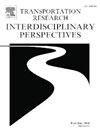智利特木科通勤者的出行方式选择:个人因素与感知建筑环境的关联
IF 3.9
Q2 TRANSPORTATION
Transportation Research Interdisciplinary Perspectives
Pub Date : 2025-04-22
DOI:10.1016/j.trip.2025.101412
引用次数: 0
摘要
在通勤者的工作旅行中增加最低限度的体育活动可能会促进更积极的旅行选择,从而有利于他们的公共健康。在智利南部的中等城市特木科,大多数通勤者都在市中心工作,这导致了高峰时段通往市中心的大部分道路拥堵。本研究旨在探讨特穆科通勤者的各种交通方式与相关的个人、社会和建成环境因素之间的关系。研究人员对来自6个社区的644名受访者进行了调查,并使用多项逻辑回归分析了通勤者的实际和首选模式选择。这个城市有更多地使用自行车而减少使用公共交通工具的趋势。此外,研究结果还表明,年龄、种族背景、拥有自行车、步行态度和对私家车的态度等几个特征与该市通勤者的实际和首选模式选择有关。步行的理想使用方式同样与角色榜样有利相关,实际和首选的步行也被发现与两种公认的生活方式因素相关。当涉及到可感知的建筑环境特征,促进公共交通和积极出行,可达性是迄今为止最重要的。这些数据可以被城市和交通官员用来推广更环保的交通方式,比如公共交通和主动出行,作为通勤者日常出行的私人车辆的替代品。本文章由计算机程序翻译,如有差异,请以英文原文为准。
Travel mode choice of the commuters in Temuco, Chile: The association of personal factors and perceived built environment
Increasing the minimal rate of physical activity on commuters’ work travels might benefit their public health by promoting more active travel options. Most commuters in Temuco, a medium-size city in southern Chile, work in the city center, which has led to congestion on most of the roadways that connect to the city’s center during rush hour. This study aimed to investigate the relationships between Temuco commuters’ various modes of transportation and the relevant personal, social, and built environment factors. The objective was examined using 644 respondents from six neighborhoods and the data was analyzed using multinomial logistic regression for both actual and preferred mode choice of the commuters. There is a trend in this city toward greater usage of bicycles and a decreased use of public transportation. In addition, the findings show that several features such as such as age, ethnic background, bicycle ownership, walking attitude, and attitude toward a private car, are associated with the commuters’ actual and preferred mode choice in this city. The desired usage of walking is likewise favorably correlated with role models, and actual and preferred walking was also found to be correlated with two recognized lifestyle factors. When it comes to perceived built environment features that promote public transportation and active travel, accessibility is by far the most significant. These data could be used by the city’s urban and transportation officials to promote more environmentally friendly modes of transportation, such as public transportation and active travel, as alternatives to private vehicles for commuters’ everyday trips.
求助全文
通过发布文献求助,成功后即可免费获取论文全文。
去求助
来源期刊

Transportation Research Interdisciplinary Perspectives
Engineering-Automotive Engineering
CiteScore
12.90
自引率
0.00%
发文量
185
审稿时长
22 weeks
 求助内容:
求助内容: 应助结果提醒方式:
应助结果提醒方式:


